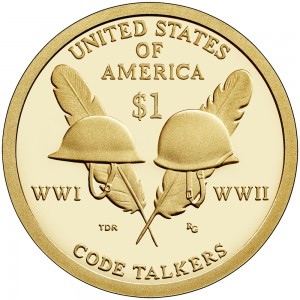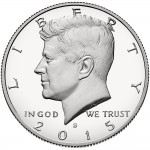
2016 Native American Dollar celebrates the contributions of the Native American Code Talkers in World War I and World War II
The reverse designs has represented some of the best work by the artists working with the U.S. Mint with the 2016 design continuing the record. Celebrating the Native American Code Talkers who were instrumental in using their native language to communicate troop movements and enemy positions, the reverse of the coin celebrates their work.
As someone who has made a career in technology and information security, the concept of using something as low-tech as a language that nobody else can translate to openly communicate secret information is an elegant solution. It proves that technology is an answer but not the only answer. It makes these people heroes for their service to a country that has not treated their people fairly over the course of history.
Learning and honoring the history of Native Americans was the goal of the Native American $1 Coin Act. It is a simple yet effective way to bring history to the masses. Although the dollar coin does not circulate well, it is still a nice way for the country to teach and honor history.
I was thinking about what could be done to honor other aspects of United States history. Why not use another coin to celebrate something that has shaped the country in some way. With over 200 years of history, there is a lot to choose from. I propose that beginning in 2017 the reverse of the Kennedy half-dollar be changed every year to celebrate an anniversary of something significant in U.S. history.As I consider writing a draft version of the bill to send to my representatives in congress, I know that any good coinage program in the United States should have some guidelines. Far be it for congress to tell the U.S. Mint to do what it thinks is right. In order to satisfy something that congress would adopt and create a meaningful program, how about a Half-Dollar history program as follows:
- The obverse will remain unchanged, the edge will continue to be reeded, and the coin will remain a half-dollar
- Reverse design changes annually and only one design per year
- Half-dollar can be made for circulation and the U.S. Mint can create collector versions including silver collectibles and different finishes
- Theme for the reverse must be from 50 years prior to the year of circulation and older with anniversary dates being divisible by 25 (i.e., 50 years ago, 75, 100, 125, 150, etc.)
- Theme will be selected by the U.S. Mint in collaboration with the CCAC and the Smithsonian Institute National Museum of American History
- The U.S. Mint creates the design for the theme selected by either using in-house artists, AIP members, or may hold an open competition
- The CCAC will review the designs
- The program will have no end date
Although there was no such thing as having a minor when I went to college, I did use some of my elective credits to take some classes in history and political science. Add my masters in public policy and some people wonder why I don’t run for office (I hate the idea of begging for campaign contributions). With that background, I was able to think of a few historical events that could be honored over the next few years:
Purposely missing from this list is the 75th anniversary of Jackie Robinson’s becoming the first African-American to appear in a Major League Baseball game in 1947. I fully expect that a commemorative coin will be issued for that event. If it is not, then congress should be ashamed of itself for not doing so.


